Leadership and Change: A Timpson Case Study Analysis
VerifiedAdded on 2022/02/15
|27
|6968
|29
Case Study
AI Summary
This case study analyzes Timpson, a British retailer, focusing on its approach to understanding and leading change. The report examines the importance of change in the business environment, organizational strategies, and operational impacts. It explores the drivers of change, including technology, shareholders, and competitors, and their influence on organizational behavior. The study includes PEST and SWOT analyses to identify internal and external drivers of change, along with an evaluation of how change affects leadership, individual, and team behavior. Furthermore, it evaluates strategies used by Timpson to minimize the impact of change, such as Kurt Lewin’s Force field analysis, and provides recommendations for effective change management, including change impact analysis. The case study also discusses different types of organizational change (developmental, transitional, and transformational) and their implications, providing a comprehensive overview of Timpson's strategic adaptation and change management practices.
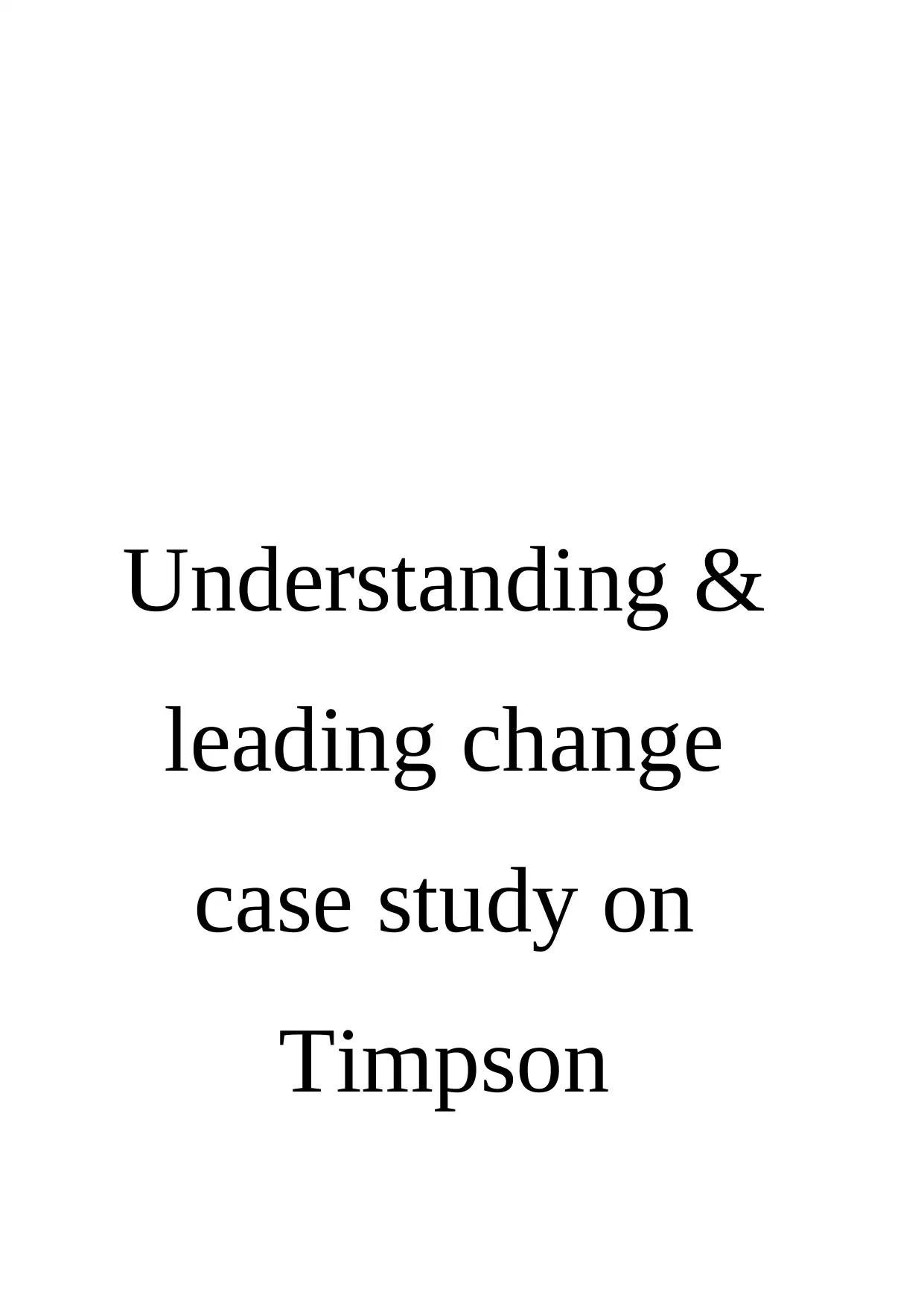
Understanding &
leading change
case study on
Timpson
leading change
case study on
Timpson
Paraphrase This Document
Need a fresh take? Get an instant paraphrase of this document with our AI Paraphraser

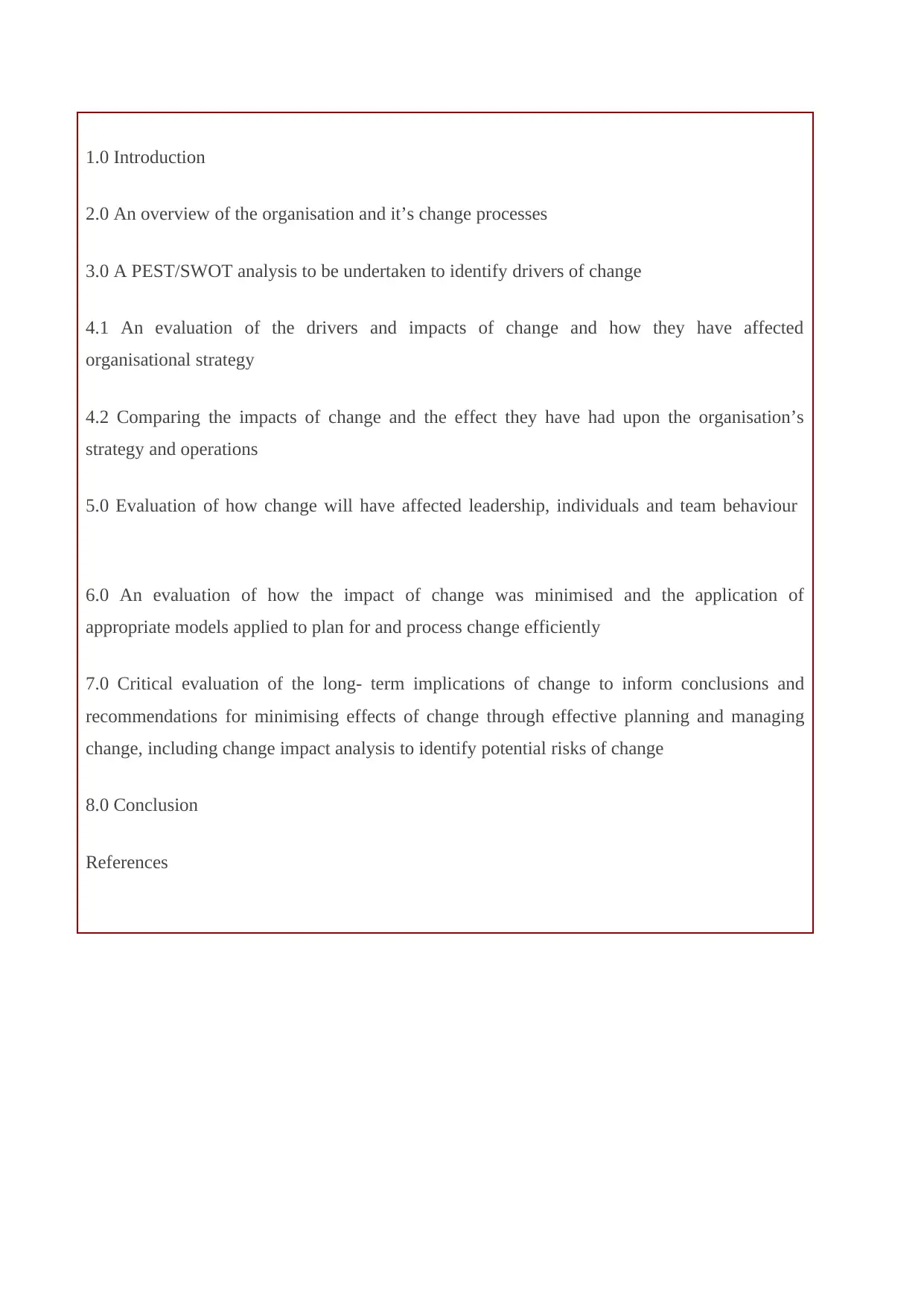
1.0 Introduction
2.0 An overview of the organisation and it’s change processes
3.0 A PEST/SWOT analysis to be undertaken to identify drivers of change
4.1 An evaluation of the drivers and impacts of change and how they have affected
organisational strategy
4.2 Comparing the impacts of change and the effect they have had upon the organisation’s
strategy and operations
5.0 Evaluation of how change will have affected leadership, individuals and team behaviour
6.0 An evaluation of how the impact of change was minimised and the application of
appropriate models applied to plan for and process change efficiently
7.0 Critical evaluation of the long- term implications of change to inform conclusions and
recommendations for minimising effects of change through effective planning and managing
change, including change impact analysis to identify potential risks of change
8.0 Conclusion
References
2.0 An overview of the organisation and it’s change processes
3.0 A PEST/SWOT analysis to be undertaken to identify drivers of change
4.1 An evaluation of the drivers and impacts of change and how they have affected
organisational strategy
4.2 Comparing the impacts of change and the effect they have had upon the organisation’s
strategy and operations
5.0 Evaluation of how change will have affected leadership, individuals and team behaviour
6.0 An evaluation of how the impact of change was minimised and the application of
appropriate models applied to plan for and process change efficiently
7.0 Critical evaluation of the long- term implications of change to inform conclusions and
recommendations for minimising effects of change through effective planning and managing
change, including change impact analysis to identify potential risks of change
8.0 Conclusion
References
⊘ This is a preview!⊘
Do you want full access?
Subscribe today to unlock all pages.

Trusted by 1+ million students worldwide
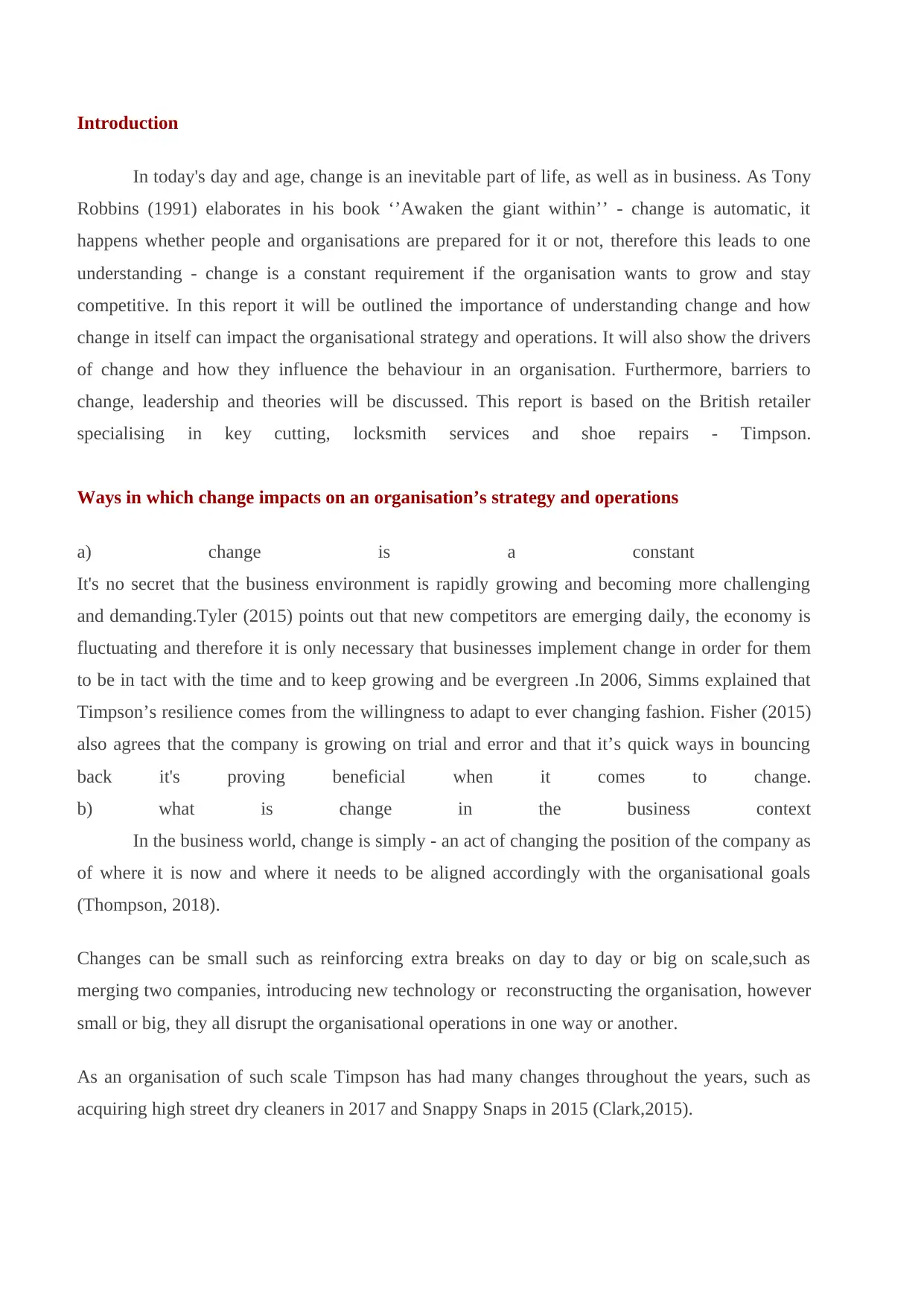
Introduction
In today's day and age, change is an inevitable part of life, as well as in business. As Tony
Robbins (1991) elaborates in his book ‘’Awaken the giant within’’ - change is automatic, it
happens whether people and organisations are prepared for it or not, therefore this leads to one
understanding - change is a constant requirement if the organisation wants to grow and stay
competitive. In this report it will be outlined the importance of understanding change and how
change in itself can impact the organisational strategy and operations. It will also show the drivers
of change and how they influence the behaviour in an organisation. Furthermore, barriers to
change, leadership and theories will be discussed. This report is based on the British retailer
specialising in key cutting, locksmith services and shoe repairs - Timpson.
Ways in which change impacts on an organisation’s strategy and operations
a) change is a constant
It's no secret that the business environment is rapidly growing and becoming more challenging
and demanding.Tyler (2015) points out that new competitors are emerging daily, the economy is
fluctuating and therefore it is only necessary that businesses implement change in order for them
to be in tact with the time and to keep growing and be evergreen .In 2006, Simms explained that
Timpson’s resilience comes from the willingness to adapt to ever changing fashion. Fisher (2015)
also agrees that the company is growing on trial and error and that it’s quick ways in bouncing
back it's proving beneficial when it comes to change.
b) what is change in the business context
In the business world, change is simply - an act of changing the position of the company as
of where it is now and where it needs to be aligned accordingly with the organisational goals
(Thompson, 2018).
Changes can be small such as reinforcing extra breaks on day to day or big on scale,such as
merging two companies, introducing new technology or reconstructing the organisation, however
small or big, they all disrupt the organisational operations in one way or another.
As an organisation of such scale Timpson has had many changes throughout the years, such as
acquiring high street dry cleaners in 2017 and Snappy Snaps in 2015 (Clark,2015).
In today's day and age, change is an inevitable part of life, as well as in business. As Tony
Robbins (1991) elaborates in his book ‘’Awaken the giant within’’ - change is automatic, it
happens whether people and organisations are prepared for it or not, therefore this leads to one
understanding - change is a constant requirement if the organisation wants to grow and stay
competitive. In this report it will be outlined the importance of understanding change and how
change in itself can impact the organisational strategy and operations. It will also show the drivers
of change and how they influence the behaviour in an organisation. Furthermore, barriers to
change, leadership and theories will be discussed. This report is based on the British retailer
specialising in key cutting, locksmith services and shoe repairs - Timpson.
Ways in which change impacts on an organisation’s strategy and operations
a) change is a constant
It's no secret that the business environment is rapidly growing and becoming more challenging
and demanding.Tyler (2015) points out that new competitors are emerging daily, the economy is
fluctuating and therefore it is only necessary that businesses implement change in order for them
to be in tact with the time and to keep growing and be evergreen .In 2006, Simms explained that
Timpson’s resilience comes from the willingness to adapt to ever changing fashion. Fisher (2015)
also agrees that the company is growing on trial and error and that it’s quick ways in bouncing
back it's proving beneficial when it comes to change.
b) what is change in the business context
In the business world, change is simply - an act of changing the position of the company as
of where it is now and where it needs to be aligned accordingly with the organisational goals
(Thompson, 2018).
Changes can be small such as reinforcing extra breaks on day to day or big on scale,such as
merging two companies, introducing new technology or reconstructing the organisation, however
small or big, they all disrupt the organisational operations in one way or another.
As an organisation of such scale Timpson has had many changes throughout the years, such as
acquiring high street dry cleaners in 2017 and Snappy Snaps in 2015 (Clark,2015).
Paraphrase This Document
Need a fresh take? Get an instant paraphrase of this document with our AI Paraphraser
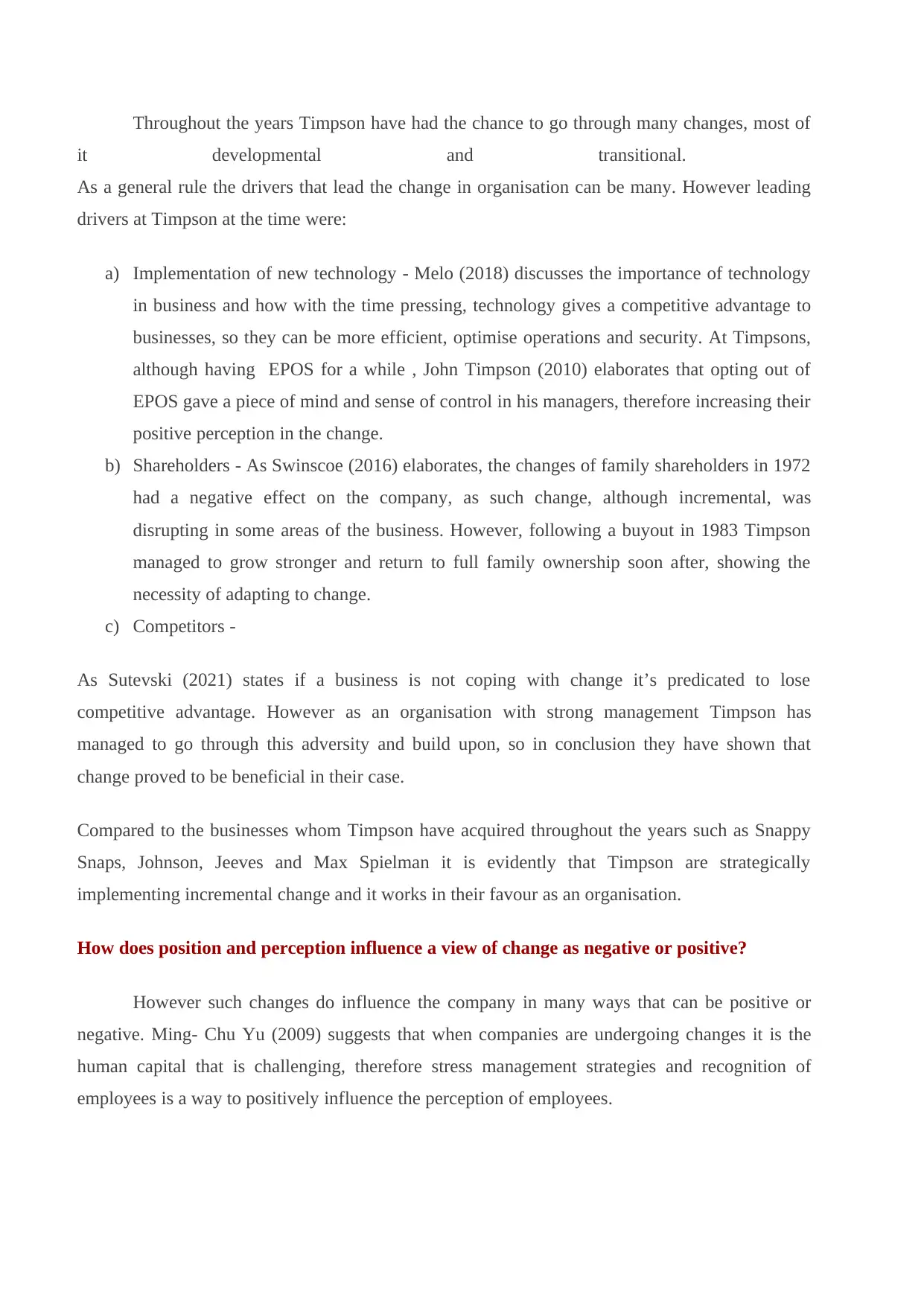
Throughout the years Timpson have had the chance to go through many changes, most of
it developmental and transitional.
As a general rule the drivers that lead the change in organisation can be many. However leading
drivers at Timpson at the time were:
a) Implementation of new technology - Melo (2018) discusses the importance of technology
in business and how with the time pressing, technology gives a competitive advantage to
businesses, so they can be more efficient, optimise operations and security. At Timpsons,
although having EPOS for a while , John Timpson (2010) elaborates that opting out of
EPOS gave a piece of mind and sense of control in his managers, therefore increasing their
positive perception in the change.
b) Shareholders - As Swinscoe (2016) elaborates, the changes of family shareholders in 1972
had a negative effect on the company, as such change, although incremental, was
disrupting in some areas of the business. However, following a buyout in 1983 Timpson
managed to grow stronger and return to full family ownership soon after, showing the
necessity of adapting to change.
c) Competitors -
As Sutevski (2021) states if a business is not coping with change it’s predicated to lose
competitive advantage. However as an organisation with strong management Timpson has
managed to go through this adversity and build upon, so in conclusion they have shown that
change proved to be beneficial in their case.
Compared to the businesses whom Timpson have acquired throughout the years such as Snappy
Snaps, Johnson, Jeeves and Max Spielman it is evidently that Timpson are strategically
implementing incremental change and it works in their favour as an organisation.
How does position and perception influence a view of change as negative or positive?
However such changes do influence the company in many ways that can be positive or
negative. Ming- Chu Yu (2009) suggests that when companies are undergoing changes it is the
human capital that is challenging, therefore stress management strategies and recognition of
employees is a way to positively influence the perception of employees.
it developmental and transitional.
As a general rule the drivers that lead the change in organisation can be many. However leading
drivers at Timpson at the time were:
a) Implementation of new technology - Melo (2018) discusses the importance of technology
in business and how with the time pressing, technology gives a competitive advantage to
businesses, so they can be more efficient, optimise operations and security. At Timpsons,
although having EPOS for a while , John Timpson (2010) elaborates that opting out of
EPOS gave a piece of mind and sense of control in his managers, therefore increasing their
positive perception in the change.
b) Shareholders - As Swinscoe (2016) elaborates, the changes of family shareholders in 1972
had a negative effect on the company, as such change, although incremental, was
disrupting in some areas of the business. However, following a buyout in 1983 Timpson
managed to grow stronger and return to full family ownership soon after, showing the
necessity of adapting to change.
c) Competitors -
As Sutevski (2021) states if a business is not coping with change it’s predicated to lose
competitive advantage. However as an organisation with strong management Timpson has
managed to go through this adversity and build upon, so in conclusion they have shown that
change proved to be beneficial in their case.
Compared to the businesses whom Timpson have acquired throughout the years such as Snappy
Snaps, Johnson, Jeeves and Max Spielman it is evidently that Timpson are strategically
implementing incremental change and it works in their favour as an organisation.
How does position and perception influence a view of change as negative or positive?
However such changes do influence the company in many ways that can be positive or
negative. Ming- Chu Yu (2009) suggests that when companies are undergoing changes it is the
human capital that is challenging, therefore stress management strategies and recognition of
employees is a way to positively influence the perception of employees.
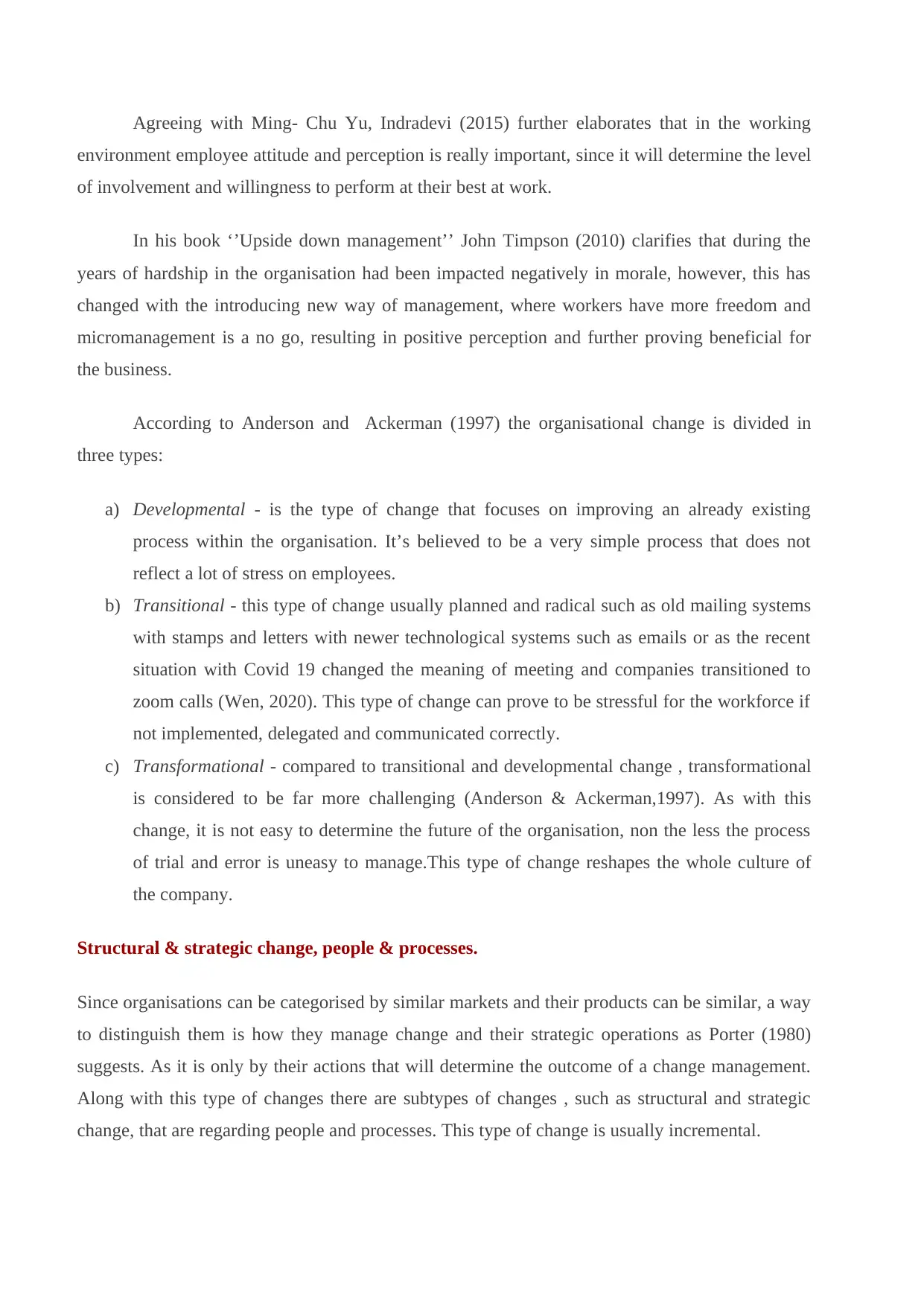
Agreeing with Ming- Chu Yu, Indradevi (2015) further elaborates that in the working
environment employee attitude and perception is really important, since it will determine the level
of involvement and willingness to perform at their best at work.
In his book ‘’Upside down management’’ John Timpson (2010) clarifies that during the
years of hardship in the organisation had been impacted negatively in morale, however, this has
changed with the introducing new way of management, where workers have more freedom and
micromanagement is a no go, resulting in positive perception and further proving beneficial for
the business.
According to Anderson and Ackerman (1997) the organisational change is divided in
three types:
a) Developmental - is the type of change that focuses on improving an already existing
process within the organisation. It’s believed to be a very simple process that does not
reflect a lot of stress on employees.
b) Transitional - this type of change usually planned and radical such as old mailing systems
with stamps and letters with newer technological systems such as emails or as the recent
situation with Covid 19 changed the meaning of meeting and companies transitioned to
zoom calls (Wen, 2020). This type of change can prove to be stressful for the workforce if
not implemented, delegated and communicated correctly.
c) Transformational - compared to transitional and developmental change , transformational
is considered to be far more challenging (Anderson & Ackerman,1997). As with this
change, it is not easy to determine the future of the organisation, non the less the process
of trial and error is uneasy to manage.This type of change reshapes the whole culture of
the company.
Structural & strategic change, people & processes.
Since organisations can be categorised by similar markets and their products can be similar, a way
to distinguish them is how they manage change and their strategic operations as Porter (1980)
suggests. As it is only by their actions that will determine the outcome of a change management.
Along with this type of changes there are subtypes of changes , such as structural and strategic
change, that are regarding people and processes. This type of change is usually incremental.
environment employee attitude and perception is really important, since it will determine the level
of involvement and willingness to perform at their best at work.
In his book ‘’Upside down management’’ John Timpson (2010) clarifies that during the
years of hardship in the organisation had been impacted negatively in morale, however, this has
changed with the introducing new way of management, where workers have more freedom and
micromanagement is a no go, resulting in positive perception and further proving beneficial for
the business.
According to Anderson and Ackerman (1997) the organisational change is divided in
three types:
a) Developmental - is the type of change that focuses on improving an already existing
process within the organisation. It’s believed to be a very simple process that does not
reflect a lot of stress on employees.
b) Transitional - this type of change usually planned and radical such as old mailing systems
with stamps and letters with newer technological systems such as emails or as the recent
situation with Covid 19 changed the meaning of meeting and companies transitioned to
zoom calls (Wen, 2020). This type of change can prove to be stressful for the workforce if
not implemented, delegated and communicated correctly.
c) Transformational - compared to transitional and developmental change , transformational
is considered to be far more challenging (Anderson & Ackerman,1997). As with this
change, it is not easy to determine the future of the organisation, non the less the process
of trial and error is uneasy to manage.This type of change reshapes the whole culture of
the company.
Structural & strategic change, people & processes.
Since organisations can be categorised by similar markets and their products can be similar, a way
to distinguish them is how they manage change and their strategic operations as Porter (1980)
suggests. As it is only by their actions that will determine the outcome of a change management.
Along with this type of changes there are subtypes of changes , such as structural and strategic
change, that are regarding people and processes. This type of change is usually incremental.
⊘ This is a preview!⊘
Do you want full access?
Subscribe today to unlock all pages.

Trusted by 1+ million students worldwide
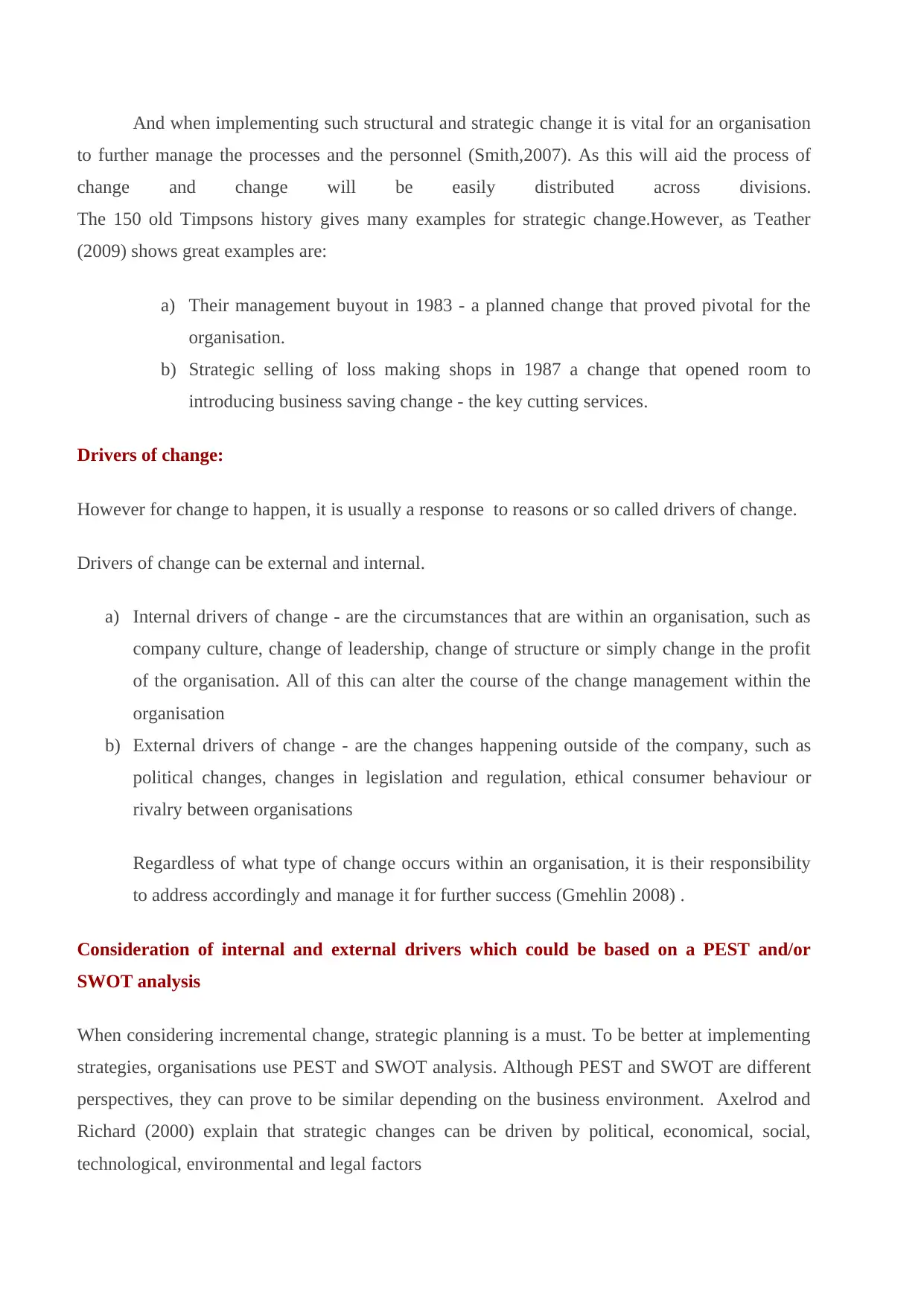
And when implementing such structural and strategic change it is vital for an organisation
to further manage the processes and the personnel (Smith,2007). As this will aid the process of
change and change will be easily distributed across divisions.
The 150 old Timpsons history gives many examples for strategic change.However, as Teather
(2009) shows great examples are:
a) Their management buyout in 1983 - a planned change that proved pivotal for the
organisation.
b) Strategic selling of loss making shops in 1987 a change that opened room to
introducing business saving change - the key cutting services.
Drivers of change:
However for change to happen, it is usually a response to reasons or so called drivers of change.
Drivers of change can be external and internal.
a) Internal drivers of change - are the circumstances that are within an organisation, such as
company culture, change of leadership, change of structure or simply change in the profit
of the organisation. All of this can alter the course of the change management within the
organisation
b) External drivers of change - are the changes happening outside of the company, such as
political changes, changes in legislation and regulation, ethical consumer behaviour or
rivalry between organisations
Regardless of what type of change occurs within an organisation, it is their responsibility
to address accordingly and manage it for further success (Gmehlin 2008) .
Consideration of internal and external drivers which could be based on a PEST and/or
SWOT analysis
When considering incremental change, strategic planning is a must. To be better at implementing
strategies, organisations use PEST and SWOT analysis. Although PEST and SWOT are different
perspectives, they can prove to be similar depending on the business environment. Axelrod and
Richard (2000) explain that strategic changes can be driven by political, economical, social,
technological, environmental and legal factors
to further manage the processes and the personnel (Smith,2007). As this will aid the process of
change and change will be easily distributed across divisions.
The 150 old Timpsons history gives many examples for strategic change.However, as Teather
(2009) shows great examples are:
a) Their management buyout in 1983 - a planned change that proved pivotal for the
organisation.
b) Strategic selling of loss making shops in 1987 a change that opened room to
introducing business saving change - the key cutting services.
Drivers of change:
However for change to happen, it is usually a response to reasons or so called drivers of change.
Drivers of change can be external and internal.
a) Internal drivers of change - are the circumstances that are within an organisation, such as
company culture, change of leadership, change of structure or simply change in the profit
of the organisation. All of this can alter the course of the change management within the
organisation
b) External drivers of change - are the changes happening outside of the company, such as
political changes, changes in legislation and regulation, ethical consumer behaviour or
rivalry between organisations
Regardless of what type of change occurs within an organisation, it is their responsibility
to address accordingly and manage it for further success (Gmehlin 2008) .
Consideration of internal and external drivers which could be based on a PEST and/or
SWOT analysis
When considering incremental change, strategic planning is a must. To be better at implementing
strategies, organisations use PEST and SWOT analysis. Although PEST and SWOT are different
perspectives, they can prove to be similar depending on the business environment. Axelrod and
Richard (2000) explain that strategic changes can be driven by political, economical, social,
technological, environmental and legal factors
Paraphrase This Document
Need a fresh take? Get an instant paraphrase of this document with our AI Paraphraser
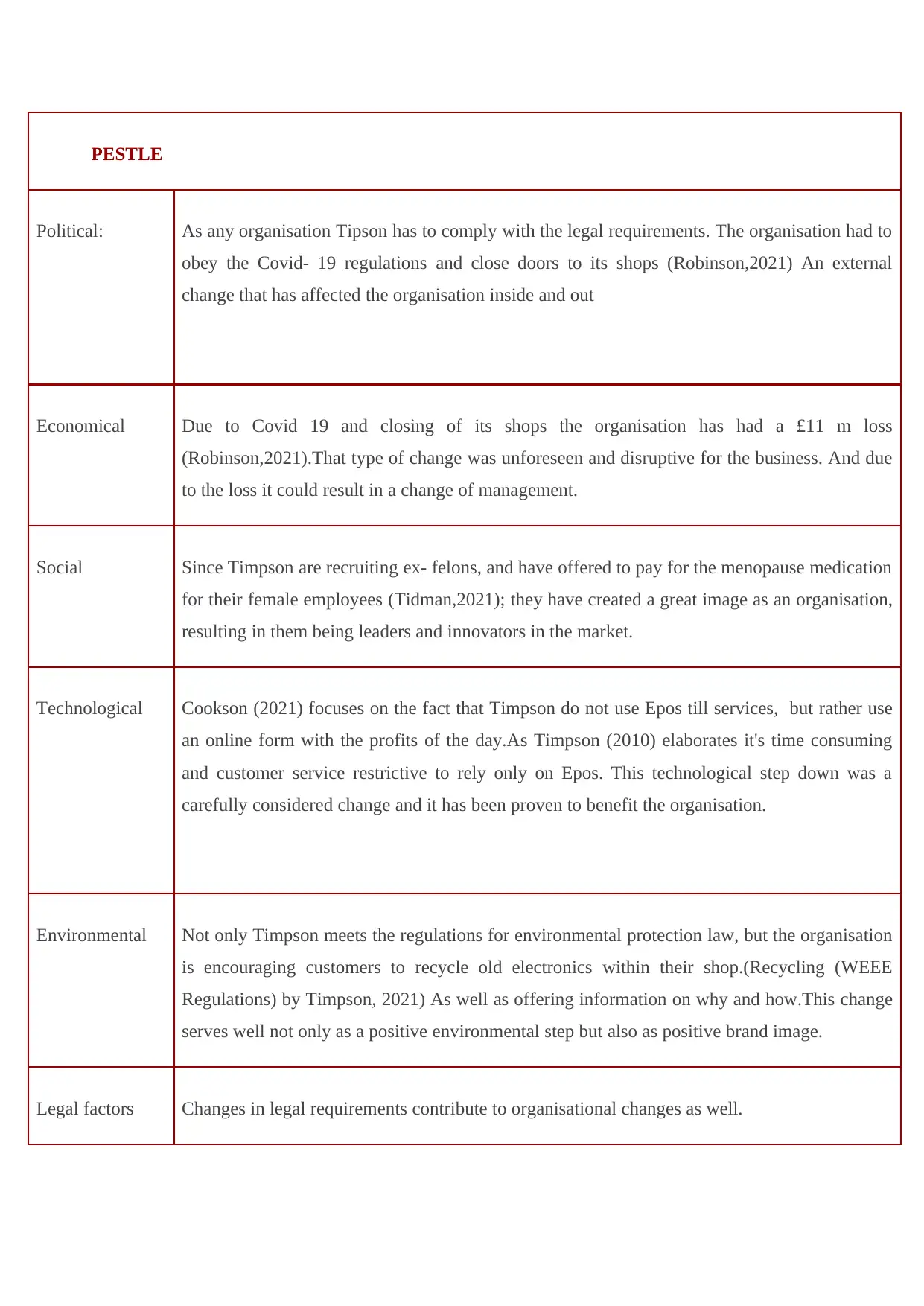
PESTLE
Political: As any organisation Tipson has to comply with the legal requirements. The organisation had to
obey the Covid- 19 regulations and close doors to its shops (Robinson,2021) An external
change that has affected the organisation inside and out
Economical Due to Covid 19 and closing of its shops the organisation has had a £11 m loss
(Robinson,2021).That type of change was unforeseen and disruptive for the business. And due
to the loss it could result in a change of management.
Social Since Timpson are recruiting ex- felons, and have offered to pay for the menopause medication
for their female employees (Tidman,2021); they have created a great image as an organisation,
resulting in them being leaders and innovators in the market.
Technological Cookson (2021) focuses on the fact that Timpson do not use Epos till services, but rather use
an online form with the profits of the day.As Timpson (2010) elaborates it's time consuming
and customer service restrictive to rely only on Epos. This technological step down was a
carefully considered change and it has been proven to benefit the organisation.
Environmental Not only Timpson meets the regulations for environmental protection law, but the organisation
is encouraging customers to recycle old electronics within their shop.(Recycling (WEEE
Regulations) by Timpson, 2021) As well as offering information on why and how.This change
serves well not only as a positive environmental step but also as positive brand image.
Legal factors Changes in legal requirements contribute to organisational changes as well.
Political: As any organisation Tipson has to comply with the legal requirements. The organisation had to
obey the Covid- 19 regulations and close doors to its shops (Robinson,2021) An external
change that has affected the organisation inside and out
Economical Due to Covid 19 and closing of its shops the organisation has had a £11 m loss
(Robinson,2021).That type of change was unforeseen and disruptive for the business. And due
to the loss it could result in a change of management.
Social Since Timpson are recruiting ex- felons, and have offered to pay for the menopause medication
for their female employees (Tidman,2021); they have created a great image as an organisation,
resulting in them being leaders and innovators in the market.
Technological Cookson (2021) focuses on the fact that Timpson do not use Epos till services, but rather use
an online form with the profits of the day.As Timpson (2010) elaborates it's time consuming
and customer service restrictive to rely only on Epos. This technological step down was a
carefully considered change and it has been proven to benefit the organisation.
Environmental Not only Timpson meets the regulations for environmental protection law, but the organisation
is encouraging customers to recycle old electronics within their shop.(Recycling (WEEE
Regulations) by Timpson, 2021) As well as offering information on why and how.This change
serves well not only as a positive environmental step but also as positive brand image.
Legal factors Changes in legal requirements contribute to organisational changes as well.
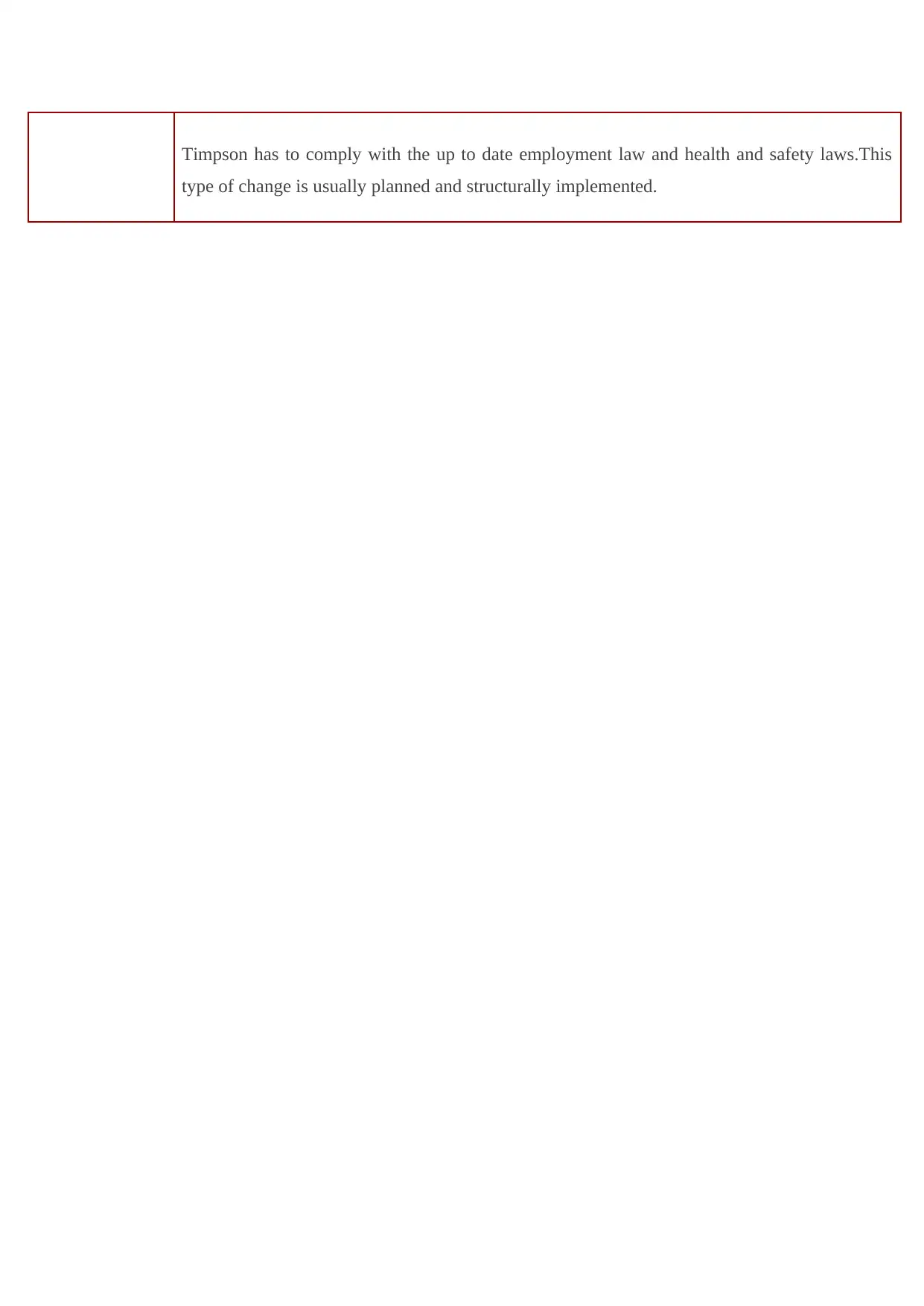
Timpson has to comply with the up to date employment law and health and safety laws.This
type of change is usually planned and structurally implemented.
type of change is usually planned and structurally implemented.
⊘ This is a preview!⊘
Do you want full access?
Subscribe today to unlock all pages.

Trusted by 1+ million students worldwide
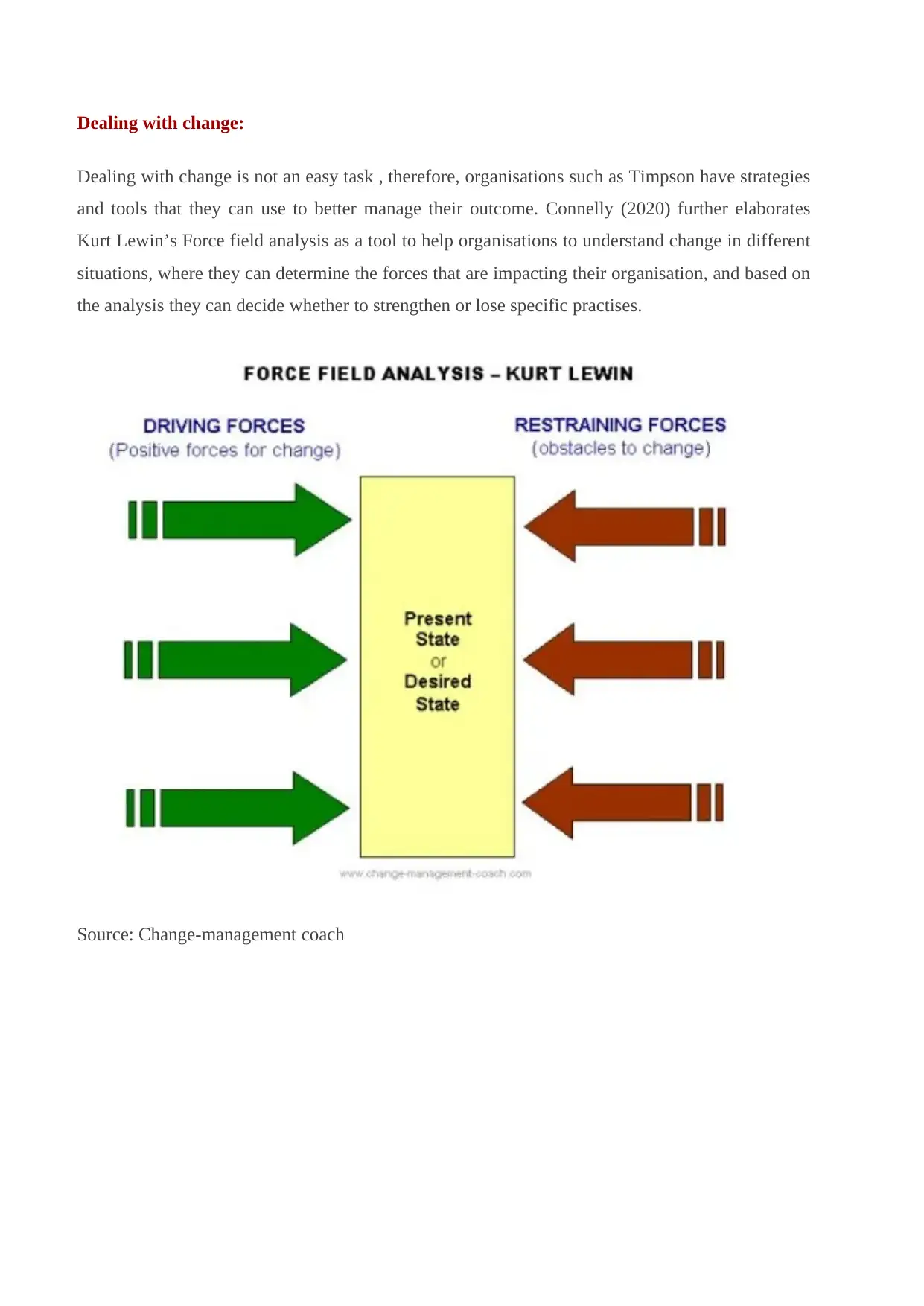
Dealing with change:
Dealing with change is not an easy task , therefore, organisations such as Timpson have strategies
and tools that they can use to better manage their outcome. Connelly (2020) further elaborates
Kurt Lewin’s Force field analysis as a tool to help organisations to understand change in different
situations, where they can determine the forces that are impacting their organisation, and based on
the analysis they can decide whether to strengthen or lose specific practises.
Source: Change-management coach
Dealing with change is not an easy task , therefore, organisations such as Timpson have strategies
and tools that they can use to better manage their outcome. Connelly (2020) further elaborates
Kurt Lewin’s Force field analysis as a tool to help organisations to understand change in different
situations, where they can determine the forces that are impacting their organisation, and based on
the analysis they can decide whether to strengthen or lose specific practises.
Source: Change-management coach
Paraphrase This Document
Need a fresh take? Get an instant paraphrase of this document with our AI Paraphraser
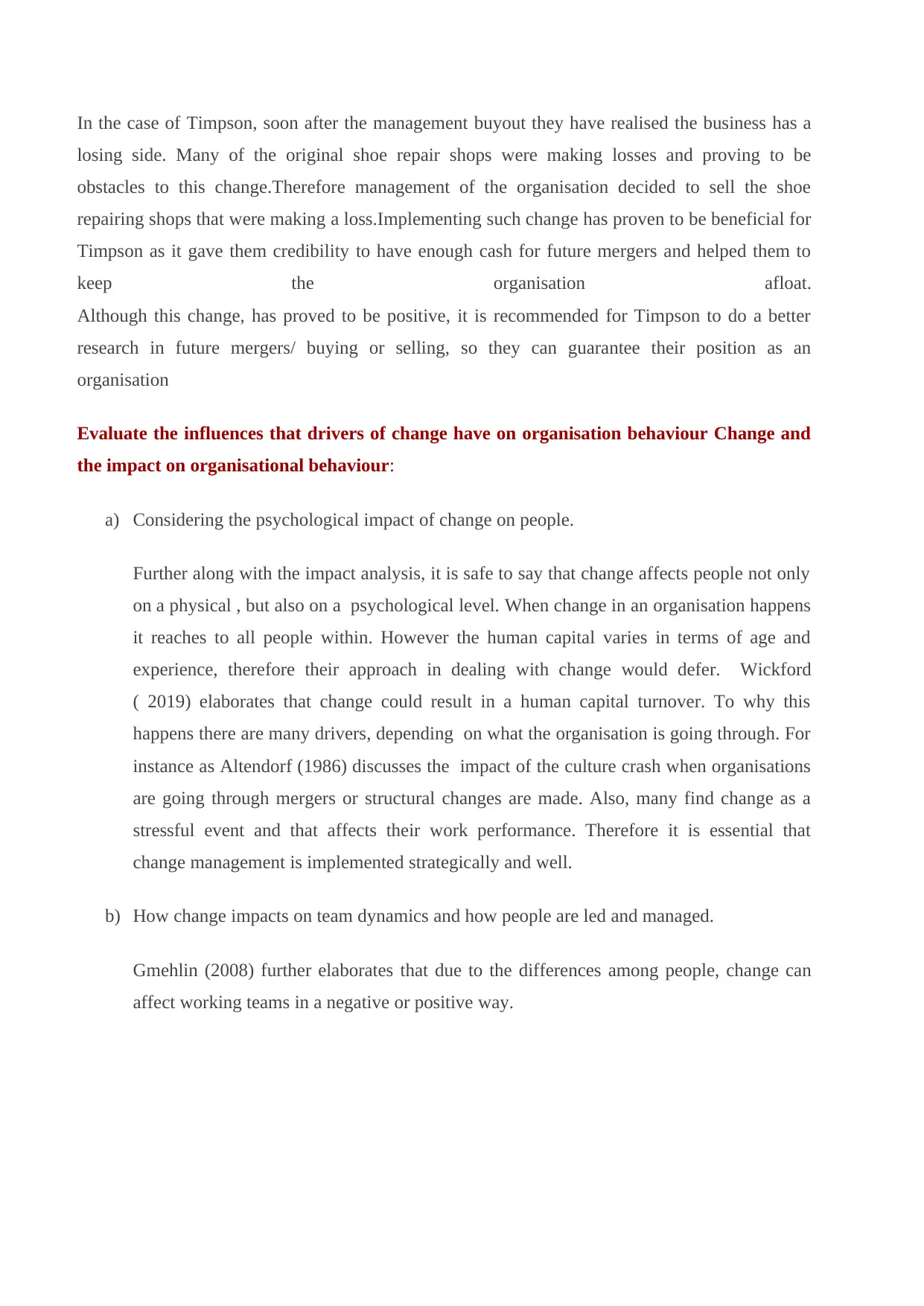
In the case of Timpson, soon after the management buyout they have realised the business has a
losing side. Many of the original shoe repair shops were making losses and proving to be
obstacles to this change.Therefore management of the organisation decided to sell the shoe
repairing shops that were making a loss.Implementing such change has proven to be beneficial for
Timpson as it gave them credibility to have enough cash for future mergers and helped them to
keep the organisation afloat.
Although this change, has proved to be positive, it is recommended for Timpson to do a better
research in future mergers/ buying or selling, so they can guarantee their position as an
organisation
Evaluate the influences that drivers of change have on organisation behaviour Change and
the impact on organisational behaviour:
a) Considering the psychological impact of change on people.
Further along with the impact analysis, it is safe to say that change affects people not only
on a physical , but also on a psychological level. When change in an organisation happens
it reaches to all people within. However the human capital varies in terms of age and
experience, therefore their approach in dealing with change would defer. Wickford
( 2019) elaborates that change could result in a human capital turnover. To why this
happens there are many drivers, depending on what the organisation is going through. For
instance as Altendorf (1986) discusses the impact of the culture crash when organisations
are going through mergers or structural changes are made. Also, many find change as a
stressful event and that affects their work performance. Therefore it is essential that
change management is implemented strategically and well.
b) How change impacts on team dynamics and how people are led and managed.
Gmehlin (2008) further elaborates that due to the differences among people, change can
affect working teams in a negative or positive way.
losing side. Many of the original shoe repair shops were making losses and proving to be
obstacles to this change.Therefore management of the organisation decided to sell the shoe
repairing shops that were making a loss.Implementing such change has proven to be beneficial for
Timpson as it gave them credibility to have enough cash for future mergers and helped them to
keep the organisation afloat.
Although this change, has proved to be positive, it is recommended for Timpson to do a better
research in future mergers/ buying or selling, so they can guarantee their position as an
organisation
Evaluate the influences that drivers of change have on organisation behaviour Change and
the impact on organisational behaviour:
a) Considering the psychological impact of change on people.
Further along with the impact analysis, it is safe to say that change affects people not only
on a physical , but also on a psychological level. When change in an organisation happens
it reaches to all people within. However the human capital varies in terms of age and
experience, therefore their approach in dealing with change would defer. Wickford
( 2019) elaborates that change could result in a human capital turnover. To why this
happens there are many drivers, depending on what the organisation is going through. For
instance as Altendorf (1986) discusses the impact of the culture crash when organisations
are going through mergers or structural changes are made. Also, many find change as a
stressful event and that affects their work performance. Therefore it is essential that
change management is implemented strategically and well.
b) How change impacts on team dynamics and how people are led and managed.
Gmehlin (2008) further elaborates that due to the differences among people, change can
affect working teams in a negative or positive way.
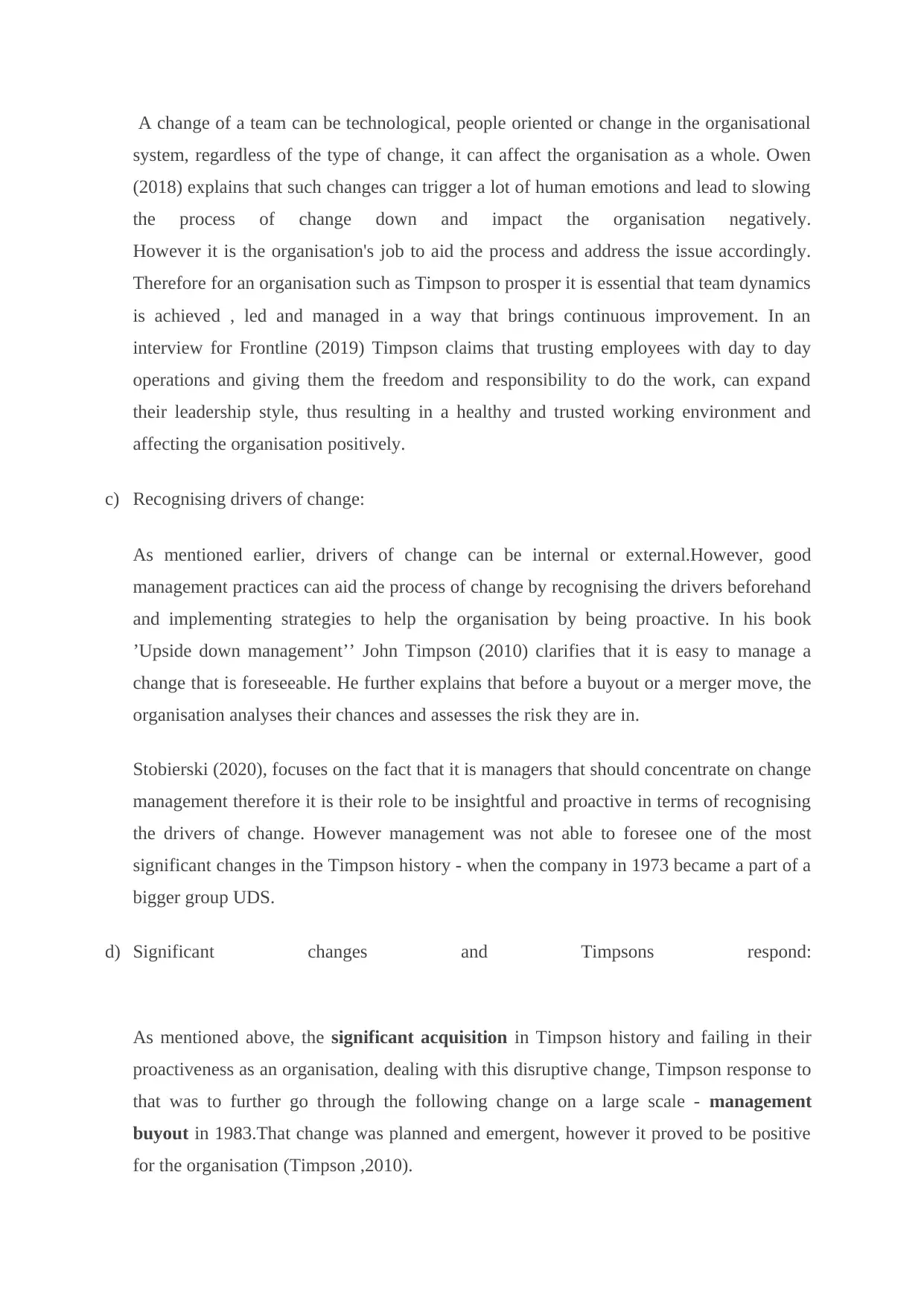
A change of a team can be technological, people oriented or change in the organisational
system, regardless of the type of change, it can affect the organisation as a whole. Owen
(2018) explains that such changes can trigger a lot of human emotions and lead to slowing
the process of change down and impact the organisation negatively.
However it is the organisation's job to aid the process and address the issue accordingly.
Therefore for an organisation such as Timpson to prosper it is essential that team dynamics
is achieved , led and managed in a way that brings continuous improvement. In an
interview for Frontline (2019) Timpson claims that trusting employees with day to day
operations and giving them the freedom and responsibility to do the work, can expand
their leadership style, thus resulting in a healthy and trusted working environment and
affecting the organisation positively.
c) Recognising drivers of change:
As mentioned earlier, drivers of change can be internal or external.However, good
management practices can aid the process of change by recognising the drivers beforehand
and implementing strategies to help the organisation by being proactive. In his book
’Upside down management’’ John Timpson (2010) clarifies that it is easy to manage a
change that is foreseeable. He further explains that before a buyout or a merger move, the
organisation analyses their chances and assesses the risk they are in.
Stobierski (2020), focuses on the fact that it is managers that should concentrate on change
management therefore it is their role to be insightful and proactive in terms of recognising
the drivers of change. However management was not able to foresee one of the most
significant changes in the Timpson history - when the company in 1973 became a part of a
bigger group UDS.
d) Significant changes and Timpsons respond:
As mentioned above, the significant acquisition in Timpson history and failing in their
proactiveness as an organisation, dealing with this disruptive change, Timpson response to
that was to further go through the following change on a large scale - management
buyout in 1983.That change was planned and emergent, however it proved to be positive
for the organisation (Timpson ,2010).
system, regardless of the type of change, it can affect the organisation as a whole. Owen
(2018) explains that such changes can trigger a lot of human emotions and lead to slowing
the process of change down and impact the organisation negatively.
However it is the organisation's job to aid the process and address the issue accordingly.
Therefore for an organisation such as Timpson to prosper it is essential that team dynamics
is achieved , led and managed in a way that brings continuous improvement. In an
interview for Frontline (2019) Timpson claims that trusting employees with day to day
operations and giving them the freedom and responsibility to do the work, can expand
their leadership style, thus resulting in a healthy and trusted working environment and
affecting the organisation positively.
c) Recognising drivers of change:
As mentioned earlier, drivers of change can be internal or external.However, good
management practices can aid the process of change by recognising the drivers beforehand
and implementing strategies to help the organisation by being proactive. In his book
’Upside down management’’ John Timpson (2010) clarifies that it is easy to manage a
change that is foreseeable. He further explains that before a buyout or a merger move, the
organisation analyses their chances and assesses the risk they are in.
Stobierski (2020), focuses on the fact that it is managers that should concentrate on change
management therefore it is their role to be insightful and proactive in terms of recognising
the drivers of change. However management was not able to foresee one of the most
significant changes in the Timpson history - when the company in 1973 became a part of a
bigger group UDS.
d) Significant changes and Timpsons respond:
As mentioned above, the significant acquisition in Timpson history and failing in their
proactiveness as an organisation, dealing with this disruptive change, Timpson response to
that was to further go through the following change on a large scale - management
buyout in 1983.That change was planned and emergent, however it proved to be positive
for the organisation (Timpson ,2010).
⊘ This is a preview!⊘
Do you want full access?
Subscribe today to unlock all pages.

Trusted by 1+ million students worldwide
1 out of 27
Related Documents
Your All-in-One AI-Powered Toolkit for Academic Success.
+13062052269
info@desklib.com
Available 24*7 on WhatsApp / Email
![[object Object]](/_next/static/media/star-bottom.7253800d.svg)
Unlock your academic potential
Copyright © 2020–2025 A2Z Services. All Rights Reserved. Developed and managed by ZUCOL.





